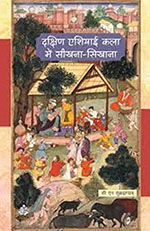This book on the historiography or rather a social-cultural history of education is a rare example of this phenomenon. Subramanium is interested in how education has been imparted over a long duration of history. He begins from the ancient, traverses the medieval and ends with the colonial period.
The first essays begins with a Sumerian archaeological site image, cuneiform tablets. Then the discussion focuses on Bharhut stupas, Ajanta frescoes and sculptures from the Mathura Museum, and Greek paintings and pottery. The second essay begins with a discussion of a sculpture from the Pala dynasty, and dwells on the medieval period, including Vijayanagara sculptures from Lepakshi temple, an image from the Bhagavat Purana, pages from Khamsa of Nizami and Razmnāma. The third chapter focuses on art that shows influences of cultural mixing, and stylistic influences, specifically in the colonial period. It is evident that the author draws on a vast range of sources.
Historians make use of records, documents, manuscripts, and texts. This book, on the other hand, is focused on the ‘image’ of the learners, teachers, learning spaces, and educational practices. It looks for them in paintings, sculpture boards, pottery, friezes, frescoes, folios from manuscripts and bas-reliefs. Subramanium shows that art is a valid document of the social and political history of education. First, the book gives a story of what happened instead of a history that focuses on problems in its narrative of events. Where are the places for teaching and learning? Are they amidst banana trees or the places where people live and work? Where do the teacher and students sit? Subramanium peers into children’s textbooks to see what they are writing, thus, veering into a micro-analysis.
Second, it engages in a range of teaching-learning processes and activities. He documents what people think and do about teaching, pedagogy, the teacher’s role, punishment and discipline. He uses classroom practices as the pivot to foray into the different dimensions.
Subramanium’s history works with the field of education, especially with the critical theory of education in the discussions. Here are a few examples of engagement with the discipline: What could be the possible beginnings of a pedagogue? Subramanium looks for clues in Greek statues made of terracotta from the 3rd century AD. How do class sizes and the number of students per teacher change over time? How do parents and teachers talk to each other? In his discussion of class, gender and caste, the foundations of critical theory are evident. What are the children wearing? Do we see boys and girls going to school together? When do the girls disappear in the school pictures? The way he looks at art and aesthetics shows how he critiques psychological and political ideas. It can be seen in discourses of punishment and discipline, the post-industrial factory model of education, and teaching-related ideas and practices. The essays cast doubt on the notion that education for life in a bureaucratized, technologically advanced society, no matter how sophisticated it is, is in any way an improvement of the human condition.
The book talks about how school systems change and stay the same. The reader can observe historical variations in how parents structure children’s lives to ensure they learn knowledge and skills that are deemed vital to survival. Preparing the next generation has indeed changed throughout time and between societies. Yet, it is undeniable that not much has changed in our classrooms. We can examine facets of life around us to determine how much has changed. This quick thought-exercise helps us realize that the only place where we still use the same tools and technologies from 4,000 years ago is in education. On the first page of the book, there is a picture of a classroom in Sumeria. Its layout is eerily similar to schools we see today.
It is also important to note that schooling was not separate from life a few centuries ago, but it is now.The school in the colony grows further distanced from everyday life. We also observe continuity in the way that most children’s childhoods are still marred by punishment and violence.
The language of the book is easy to understand as it flows like a conversation between close friends, using everyday vocabulary, concepts and ideas. The book discusses what dropouts, pedagogue, authority/power, discipline, punishment, and the link between the community and school mean. The book does justice to how it reads the images from different periods in history. Particularly significant are the junctures where Subramanium pays attention to aesthetic aspects like weight balance or visual composition.
The images in the book are, essentially, an aesthetic experience. The imagery is powerful and redolent with ideas about teaching and learning. The reader is invited to enjoy the images and understand them. One thing is certain, the mental trek we take on reading this book may inspire thoughts about the future of education. This is still possible despite the bleak and inconclusive evidence of change.
November 2023, volume 47, No 11

